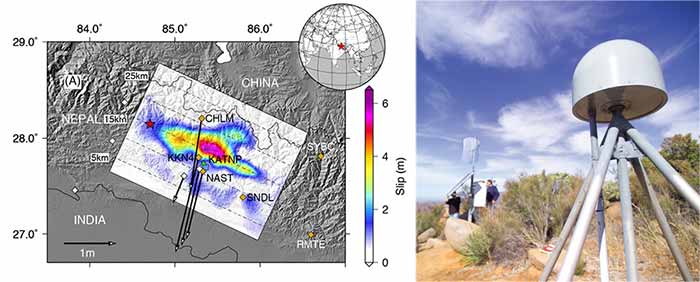International GPS Project Provides Details of Nepal Earthquake
Data shows Main Himalayan Thrust unzipping during earthquake
Published Date
By:
- Christina Wu
Share This:
Article Content

Photo of a GPS satellite and seismic movement during the April 2014 Nepal earthquake.
The 7.8 magnitude earthquake in Nepal last April was the first example of a large continental “mega-thrust” rupture that was captured by a GPS network that measures ground motion. The Himalayas are the most seismically active, above-water mountain range on Earth.
Researchers from Scripps Institution of Oceanography at UC San Diego and other colleagues found the earthquake was the result of rupture on the Main Himalayan Thrust (MHT) fault along an area 140 kilometers (74.5 miles) long and 20 kilometers (12.5 miles) wide, lasting 60 seconds, moving towards Kathmandu at a speed of 3.3 kilometers (2 miles) per second.
The researchers utilized an existing global network to understand the earthquake characteristics and ground shaking in Kathmandu using GPS data, in their study, “Slip pulse and resonance of Kathmandu basin during the 2015 Mw 7.8 Gorkha earthquake, Nepal imaged with geodesy,” which was published on August 6 in Science.
The GPS records show that despite the high magnitude and subsequent death toll, the onset of rupture was surprisingly smooth with predominantly low-frequency waves that produced long, smooth oscillations in the Kathmandu basin. This resulted in less damage to low-level buildings than could have otherwise been expected, but caused collapse of tall structures, including cultural artifacts such as the 60-meter-tall Dharahara tower in Kathmandu.
“The GPS system was able to capture the very first moments of the earthquake to characterize the more violent shaking that followed,” said Scripps geodesist Yehuda Bock, a co-author of the study. “This study demonstrated that measuring GPS signals at higher rates, five times a second or greater, is useful in determining the kinematics of the earthquake source.”
The Kathmandu basin is an ancient lakebed that is now filled with soft sediment that captured the seismic waves from below and continued to reverberate, even after the earthquake had passed, much like a bell continues to emit sound even after it has been rung. This mechanism ultimately caused the tower to completely collapse.
“GPS is critical for determining where earthquakes are likely to occur. GPS stations throughout plate boundary zones, such as the Himalayas, help us to identify likely regions where large earthquakes might occur in the future,” said Scripps alum Diego Melgar, now based at UC Berkeley, a co-author of this study. “Of course, we can't yet say when the earthquake is going to happen, but we can with some confidence identify areas of elevated hazard.”
Scientists are hopeful that the GPS networks and seismic sensors will provide early warning for earthquakes.
“If an earthquake happens in the region of a network, we can instantaneously measure the arrival of benign seismic P waves at network stations and predict when the more destructive S and surface waves will arrive at someone’s particular location,” said Bock. “An accurate magnitude for even the largest and closest events can be quickly estimated and then the expected intensity of shaking, to help minimize casualties and damage to critical infrastructure.”
Co-authors of this study include researchers from the California Institute of Technology, University of California-Berkeley, University of Cambridge, UK, Department of Mines and Geology, Kathmandu, Nepal, Nepal Academy of Science and Technology, Central Washington University, Tribhuvan University, Kathmandu, Nepal, U.S. Geological Survey (USGS), UNAVCO, CEA, DAM, DIF, Arpajon, France.
This study was funded by the following organizations: the Gordon and Betty Moore Foundation, National Science Foundation (NSF), and National Aeronautics and Space Administration (NASA).
Note: Materials from a California Institute of Technology news release were used in this article.
Share This:
You May Also Like
Stay in the Know
Keep up with all the latest from UC San Diego. Subscribe to the newsletter today.



